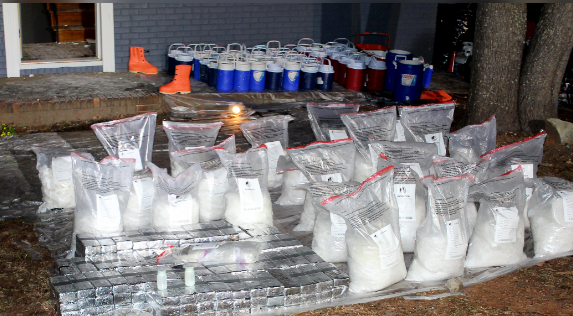
KANSAS CITY – Drug Enforcement Administration Acting Administrator Uttam Dhillon announced Thursday that the DEA will direct enforcement resources to methamphetamine “transportation hubs” — areas where methamphetamine is often trafficked in bulk and then distributed across the country. While continuing to focus on stopping drugs being smuggled across the border, DEA’s Operation Crystal Shield will ramp up enforcement to block their further distribution into America’s neighborhoods.
DEA has identified eight major methamphetamine transportation hubs where these efforts will be concentrated: Atlanta, Dallas, El Paso, Houston, Los Angeles, New Orleans, Phoenix, and the St. Louis Division. Together, these DEA Field Divisions accounted for more than 75 percent of methamphetamine seized in the U.S. in 2019.
“The superhighways of methamphetamine distribution cross Kansas,” said U.S. Attorney Stephen McAllister. “No drug has proven to be a greater threat to the peace, safety and health of our communities. Operation Crystal Shield is a much needed initiative to make Kansans safer.”
Operation Crystal Shield builds on existing DEA initiatives that target major drug trafficking networks, including the Mexican cartels that are responsible for the overwhelming majority of methamphetamine trafficked into and within the United States. From fiscal year 2017 to 2019, DEA domestic seizures of methamphetamine increased 127 percent from 49,507 pounds to 112,146 pounds. The St. Louis Division seizures were up 56 percent from fiscal year 2018 to 2019. During the same timeframe, the number of DEA arrests related to methamphetamine rose nearly 20 percent.
“For decades, methamphetamine has been a leading cause of violence and addiction – a drug threat that has never gone away,” said Acting Administrator Dhillon. “With a 22 percent increase in methamphetamine-related overdose deaths, now is the time to act, and DEA is leading the way with a surge of interdiction efforts and resources, targeting regional transportation hubs throughout the United States. By reducing the supply of meth, we reduce the violence, addiction, and death it spreads.”
The DEA St. Louis Division covers the entire states of Missouri, Kansas and the southern portion of Illinois, which encompasses hundreds of miles of interstate roadways. “These roadways are routinely utilized by drug trafficking organizations to transport methamphetamine and other deadly drugs into Kansas City metropolitan area,” said Special Agent in Charge William J. Callahan. “Operation Crystal Shield will allow our DEA agents and law enforcement partners the opportunity to strengthen our enforcement strategies in an effort to interdict drugs and disrupt drug trafficking organizations causing harm to the citizens of Kansas City.”
Special Agent in Charge Callahan added, “The DEA seeks to hold methamphetamine drug traffickers accountable through multi-jurisdictional investigations which target all facets of the drug trafficking organizations, and bring them to justice by United States Attorneys in our area of operation.”
“Methamphetamine is by far the most prevalent illegal drug being sold on the streets of our community, and therefore warrants a focused plan of attack,” said U.S. Attorney Tim Garrison. “Meth trafficking makes up more than 60 percent of the federal drug cases we prosecute in the Western District of Missouri. Operation Crystal Shield provides a strategy to stanch the flow of methamphetamine being smuggled into our state by the Mexican cartels. If we can reduce the supply of methamphetamine, we can reduce the violence and other criminal activity associated with drug trafficking.”
Virtually all methamphetamine in the United States comes through major ports of entry along the Southwest Border and is transported by tractor trailers and personal vehicles along the nation’s highways to major transfer centers around the country. It is often found in poly-drug loads, alongside cocaine, heroin, and fentanyl.



